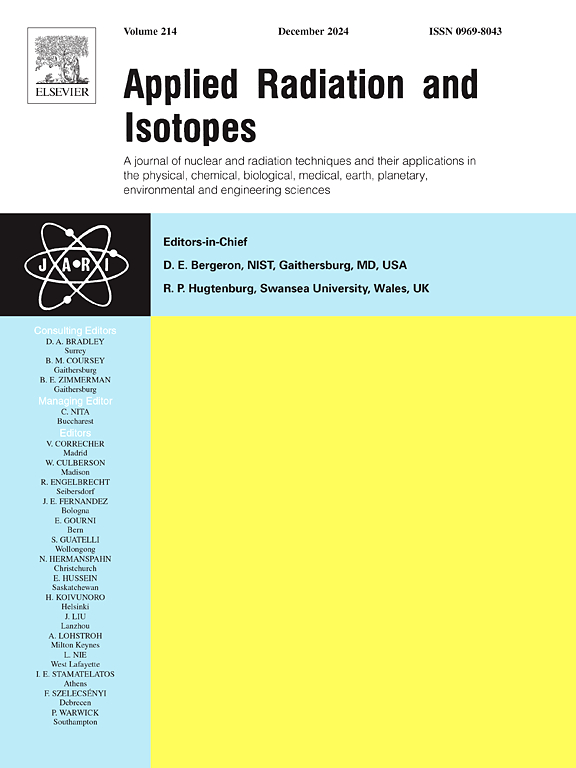为哥斯达黎加公共部门建立国家计算机断层扫描诊断参考水平:第一步
IF 1.8
3区 工程技术
Q3 CHEMISTRY, INORGANIC & NUCLEAR
引用次数: 0
摘要
背景和目的计算机断层扫描(CT)是医学诊断的关键工具,但与大量电离辐射暴露相关,因此需要通过诊断参考水平(DRLs)来优化剂量。目前的研究旨在评估CT辐射剂量,并使用CT剂量参数(如CT剂量指数体积(CTDIvol)和剂量长度积(DLP))为5个最常见的成人研究提出国家诊断参考水平(NDRL),并比较哥斯达黎加公共部门医院之间上述检查的做法。材料与方法收集哥斯达黎加11/12所公立医院2024年1 - 8月的患者和研究数据。使用剂量学参数(CTDIvol和DLP)的第50和75百分位数作为参考暴露值,对成人的五个主要解剖区域(头部、颈椎、胸部、腹部-骨盆和胸腹-骨盆)进行了分析。NDRL从每家医院和检查的中位数CTDIvol和DLP的第三个四分位数获得。结果建议的公共国家诊断参考水平(NDRLs)如下:头部检查CTDIvol为52 mGy, DLP为1239 mGy cm;颈椎为22毫戈瑞和774毫戈瑞厘米;胸部为10毫戈瑞和594毫戈瑞厘米;腹部-骨盆联合研究为14mgy和1283mgy cm;胸腹骨盆联合研究为12毫戈瑞和1498毫戈瑞厘米。总体而言,这些值与CTDIvol方面的国际参考水平一致;然而,在DLP值上观察到明显的差异,特别是胸腹骨盆检查,建议的水平超过法国NDRL高达170%。结论虽然本研究概述的NDRLs总体上是可接受的,并且与先前发表的研究结果一致,但优化辐射剂量仍然是必要的,特别是对于那些值高于参考值的设备和医院。这一分析是在哥斯达黎加建立DRLs的首次努力,为优化放射安全提供了坚实的基础。本文章由计算机程序翻译,如有差异,请以英文原文为准。
Setting up a national diagnostic reference level for computed tomography for the public sector in Costa Rica: first step
Background and aim
Computed Tomography (CT) is a key tool in medical diagnostics but is associated with significant ionizing radiation exposure, highlighting the need to optimize doses through Diagnostic Reference Levels (DRLs). The current study aimed to assess CT radiation dose and propose a National Diagnostic Reference Level (NDRL) for the 5 most frequent adult studies using CT dose parameters such as CT Dose Index Volume (CTDIvol) and Dose Length Product (DLP) as well as to compare the practices for aforementioned examinations between hospitals in Costa Rica's public sector.
Materials and methods
Data from patients and studies developed in 11/12 public hospitals in Costa Rica between January to August 2024 were collected. Procedures performed on adults for five main anatomical regions (head, cervical spine, chest, abdomen-pelvis, and chest-abdomen-pelvis) were analysed, using the 50th and 75th percentiles of dosimetric parameters (CTDIvol and DLP) as reference exposure values. The NDRL was achieved from the third quartile of median CTDIvol and DLP for each hospital and examination.
Results
The proposed public National Diagnostic Reference Levels (NDRLs) are as follows: for Head examinations, a CTDIvol of 52 mGy and a DLP of 1239 mGy cm; for Cervical Spine, 22 mGy and 774 mGy cm; for Chest, 10 mGy and 594 mGy cm; for combined Abdomen-Pelvis studies, 14 mGy and 1283 mGy cm; and for combined Chest-Abdomen-Pelvis studies, 12 mGy and 1498 mGy cm. Overall, these values align with international reference levels in terms of CTDIvol; however, notable discrepancies were observed in DLP values—particularly for Chest-Abdomen-Pelvis exams, where the proposed level exceeded the French NDRL by up to 170 %.
Conclusion
While the NDRLs outlined in this study were generally acceptable and consistent with previously published research, optimizing radiation doses remains imperative, particularly for those equipment and hospitals with values above the reference. This analysis represents the first effort to establish DRLs in Costa Rica, providing a robust foundation for optimizing radiological safety.
求助全文
通过发布文献求助,成功后即可免费获取论文全文。
去求助
来源期刊

Applied Radiation and Isotopes
工程技术-核科学技术
CiteScore
3.00
自引率
12.50%
发文量
406
审稿时长
13.5 months
期刊介绍:
Applied Radiation and Isotopes provides a high quality medium for the publication of substantial, original and scientific and technological papers on the development and peaceful application of nuclear, radiation and radionuclide techniques in chemistry, physics, biochemistry, biology, medicine, security, engineering and in the earth, planetary and environmental sciences, all including dosimetry. Nuclear techniques are defined in the broadest sense and both experimental and theoretical papers are welcome. They include the development and use of α- and β-particles, X-rays and γ-rays, neutrons and other nuclear particles and radiations from all sources, including radionuclides, synchrotron sources, cyclotrons and reactors and from the natural environment.
The journal aims to publish papers with significance to an international audience, containing substantial novelty and scientific impact. The Editors reserve the rights to reject, with or without external review, papers that do not meet these criteria.
Papers dealing with radiation processing, i.e., where radiation is used to bring about a biological, chemical or physical change in a material, should be directed to our sister journal Radiation Physics and Chemistry.
 求助内容:
求助内容: 应助结果提醒方式:
应助结果提醒方式:


